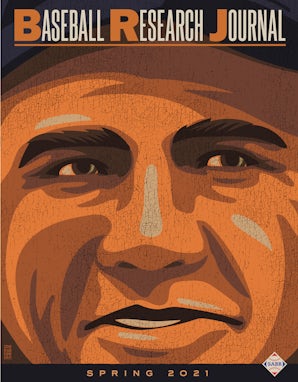About the Book
Babe Ruth continues to interest and fascinate us over 100 years after his fateful trade from Boston to New York. As Michael Haupert writes in “The Business of Being the Babe,” “Babe Ruth is frequently lauded as the greatest player in Major League Baseball history, and arguably the first true superstar athlete. Ruth transcended the game of baseball, and with the aid of agent Christy Walsh, he profited tremendously from that transcendence. Whether barnstorming, making movies, or modeling underwear, Ruth had a Midas touch that allowed his income to exceed even his famously outsized spending habits.”
ALSO IN THIS ISSUE:
“Third Things First—Carl Zamloch and the Brief History of Reversible Baseball”
by Dan Schoenholz
On February 15, 1928, the University of California baseball squad took on a local semi-pro team by the name of the Ambrose Tailors in an early-season exhibition game. “[A] crowd of 500 fans, two motion picture cameras, and four newspaper photographers” made the trek to West Field on the Berkeley campus to watch the action... a field trial of Coach Carl Zamloch’s proposed revision to the rule books, what he called “reversible” baseball. What exactly was reversible (also sometimes referred to as “left-handed” or “ambidextrous”) baseball? Simply put, batters were given the option of running to either first or third base after putting the ball in play.
“Did Batters of Long Ago Learn During a Game?”
by Jay Wigley
Modern baseball analysis has established without a doubt that the longer a pitcher stays in the game, the better the batters will perform against him. Beginning in 1996, analysts evaluated the starting lineup’s plate appearances and later coined an acronym for the rule: TTOP, for the “Times Through (the) Order Penalty.” That is, “As the game goes on, the hitter has a progressively greater advantage over the starting pitcher.” Has this TTOP always been there? This article examines whether Deadball Era batters improved their performance against the starting pitcher in the same way as their modern counterparts. Using Retrosheet data for the seasons 1916–2019, we will see that while Deadball batters also learned their opposing pitcher during a game, the pattern of their learning was different.
“Black Swans in Baseball: The Case of the Unexpected MVP Season"
by Douglas Jordan, PhD
The definition of “black swan” used in this paper is that the player wins an MVP award without having been recognized in a previous season for any aspect of his performance: no previous awards or All-Star selections. An MVP winning season is very special. Not only does the player have to have a historically excellent season, but it has to be a better season than any other great player of his era. It seems almost impossible that a previously mediocre player would be able to improve his performance significantly enough from one year to the next to win an MVP award. That’s why there have been only three non-pitchers who have won an MVP award without receiving any previous awards. Those players are Justin Morneau in 2006, and Steve Garvey and Jeff Burroughs in 1974.
